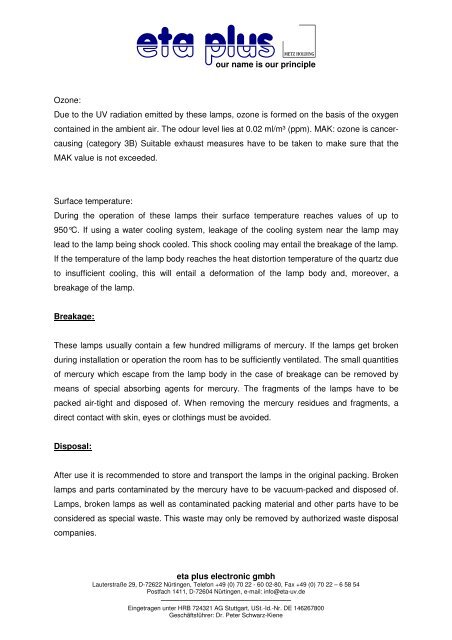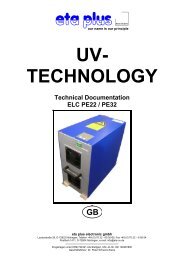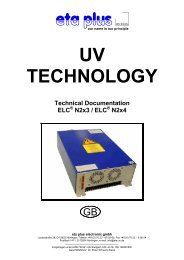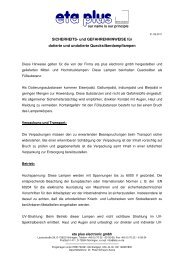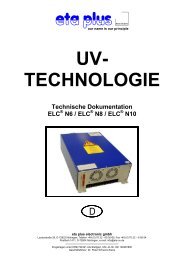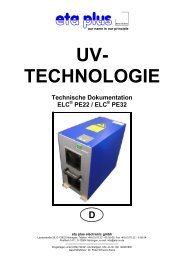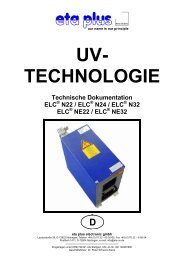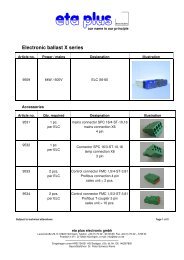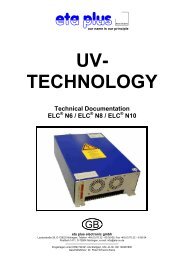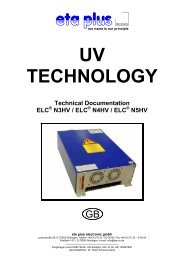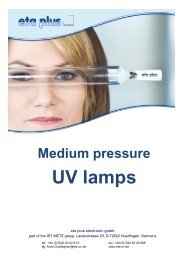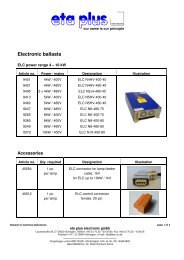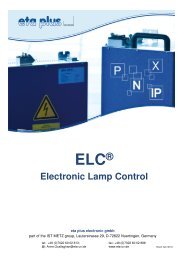Safety data sheet Hg lamp - eta plus electronic GmbH
Safety data sheet Hg lamp - eta plus electronic GmbH
Safety data sheet Hg lamp - eta plus electronic GmbH
Create successful ePaper yourself
Turn your PDF publications into a flip-book with our unique Google optimized e-Paper software.
Ozone:<br />
SICHERHEITSDATENBLATT HG-LAMPEN GB - 01.09.2011.DOC<br />
���<br />
our name is our principle<br />
<strong>eta</strong> <strong>plus</strong> <strong>electronic</strong> gmbh<br />
Lauterstraße 29, D-72622 Nürtingen, Telefon +49 (0) 70 22 - 60 02-80, Fax +49 (0) 70 22 – 6 58 54<br />
Postfach 1411, D-72604 Nürtingen, e-mail: info@<strong>eta</strong>-uv.de<br />
––––––––––––––––––––––––––––<br />
Eingetragen unter HRB 724321 AG Stuttgart, USt.-Id.-Nr. DE 146267800<br />
Geschäftsführer: Dr. Peter Schwarz-Kiene<br />
�<br />
Due to the UV radiation emitted by these <strong>lamp</strong>s, ozone is formed on the basis of the oxygen<br />
contained in the ambient air. The odour level lies at 0.02 ml/m³ (ppm). MAK: ozone is cancer-<br />
causing (category 3B) Suitable exhaust measures have to be taken to make sure that the<br />
MAK value is not exceeded.<br />
Surface temperature:<br />
During the operation of these <strong>lamp</strong>s their surface temperature reaches values of up to<br />
950°C. If using a water cooling system, leakage of the cooling system near the <strong>lamp</strong> may<br />
lead to the <strong>lamp</strong> being shock cooled. This shock cooling may entail the breakage of the <strong>lamp</strong>.<br />
If the temperature of the <strong>lamp</strong> body reaches the heat distortion temperature of the quartz due<br />
to insufficient cooling, this will entail a deformation of the <strong>lamp</strong> body and, moreover, a<br />
breakage of the <strong>lamp</strong>.<br />
Breakage:<br />
These <strong>lamp</strong>s usually contain a few hundred milligrams of mercury. If the <strong>lamp</strong>s get broken<br />
during installation or operation the room has to be sufficiently ventilated. The small quantities<br />
of mercury which escape from the <strong>lamp</strong> body in the case of breakage can be removed by<br />
means of special absorbing agents for mercury. The fragments of the <strong>lamp</strong>s have to be<br />
packed air-tight and disposed of. When removing the mercury residues and fragments, a<br />
direct contact with skin, eyes or clothings must be avoided.<br />
Disposal:<br />
After use it is recommended to store and transport the <strong>lamp</strong>s in the original packing. Broken<br />
<strong>lamp</strong>s and parts contaminated by the mercury have to be vacuum-packed and disposed of.<br />
Lamps, broken <strong>lamp</strong>s as well as contaminated packing material and other parts have to be<br />
considered as special waste. This waste may only be removed by authorized waste disposal<br />
companies.


